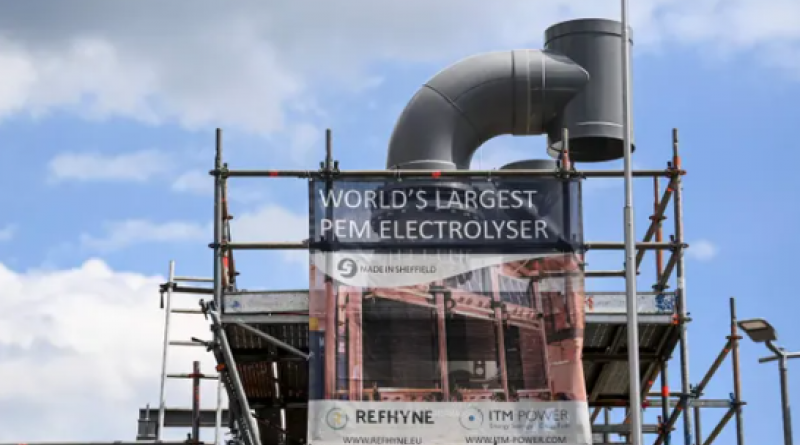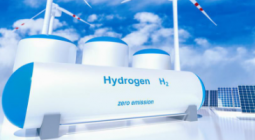Green hydrogen beats blue on emissions and financial cost, Australian study finds

Greenhouse gas emissions from hydrogen produced using fossil fuels such as natural gas are ‘substantial’, researchers say.
Hydrogen produced by fossil fuels is more expensive, will release more greenhouse gas emissions and comes with a greater risk of creating stranded assets, according to new research from the Australian National University.
In the paper, published in the peer-reviewed engineering journal Applied Energy, researchers compared the emissions and financial cost of producing hydrogen using fossil fuels or renewable energy.
“Blue hydrogen” is produced using natural gas while “green hydrogen” is made by running an electric current through water using an electrolyser powered by renewable energy such as wind or solar.
“Clean hydrogen” is the term used for when carbon capture and storage is used to capture carbon dioxide emissions during the production process, similar to proposals for “clean coal”.
Hydrogen has become central to the Australian government’s current proposal to reach net zero, and blue hydrogen was endorsed by Australia’s former chief scientist Dr Alan Finkel as a way to build industrial capability.
But the ANU researchers found emissions from hydrogen made from fossil fuels would still be “substantial”.
Researchers found current emissions estimates of CCS fail to account for fugitive emissions such as methane – a potent greenhouse gas that leaks into the atmosphere during the extraction of natural gas.
These emissions are not caught by CCS and because creating hydrogen from natural gas is not totally efficient – it takes more gas to make hydrogen for energy than it would to simply burn the gas – methane emissions will continue to grow with the rate of extraction.
As the rate of extraction grows to supply export markets, so will these emissions.
The researchers also found the financial cost of creating blue hydrogen using CCS becomes more expensive as a plant gets closer to capturing 90% of emissions. This is because it becomes harder to capture CO2 as concentrations begin to fall.
Dr Fiona Beck, a co-author of the report and an engineer with the ANU Institute for Climate, Energy and Disaster Solutions, said CCS requires an expensive “bespoke solution for every plant” which adds to the risk these projects may become stranded assets.
“Green hydrogen is more expensive right now but it has the capacity to very quickly reduce in cost,” Beck said. “Unless we have some form of incentive for people to apply CCS, it’s never going to make sense to make blue hydrogen.”
“It does beg the question who’s going to invest in blue hydrogen?”
With high capture rates the researchers put the cost of producing blue hydrogen at $2.87 (US$2.09) a kilogram per tonne of CO2, while the cost of producing green hydrogen is $4.99 (US$3.64) with projections that it may come down to $2.55 (US$1.86).
As the technology to create blue hydrogen has already been around for some time, it’s unlikely there will be a significant technological advance that would drive down price, as has happened with the production of solar panels.
A CSIRO database tracking new hydrogen projects that have been announced or are under development records at least 65 new green hydrogen projects in Australia, compared to just three trying to create hydrogen from fossil fuels and CCS.
The ANU research report is supported by other worldwide studies such as one published in September by researchers working for French energy giant Engie who found that it was already possible to produce green hydrogen for similar prices to blue hydrogen.
That study found the cost of producing hydrogen from fossil fuels was between $1.34 and $2.40 a kilogram per tonne of CO2, while it was already possible in some operations to produce hydrogen made from solar power at $2.36 a kilogram.
Scott Hamilton, a senior adviser to the Smart Energy Council and Hydrogen Australia, said the industry is a “long, long way” from achieving these costs across the board but it was up to the Australian government to actively support the develop of green hydrogen.
“The Australian government needs to do more than have hopes and prayers and magical thinking in their modelling,” Hamilton said. “They need proper targets, proper policy actions to bring these emerging technologies to market, as they did with wind and solar 20 years ago.”
Hamilton said the government was currently under-pricing blue hydrogen in its net zero modelling by assuming the price of hydrogen produced with fossil fuels to be $1.80 a kilogram, with hydrogen produced through renewable energy only becoming cost-competitive in 2030 – despite the price of natural gas growing steadily since 2015.
Dr Madeline Taylor, a senior lecturer at Macquarie University’s school of law and a climate councillor at the Climate Council of Australia, said the ANU research “confirmed the business case, the commercial viability case and the policy case” for green hydrogen.
“There’s a lot of money to be made but there’s also a lot of risk if we don’t do it right. If we don’t invest in the right technologies or send the right signals,” Taylor said.
“If we don’t think carefully, we could be left with stranded assets. We could be left producing a product the world doesn’t want. We could be left with infrastructure that is going to fall upon the taxpayer to dismantle.”
17 November 2021
The Guardian





